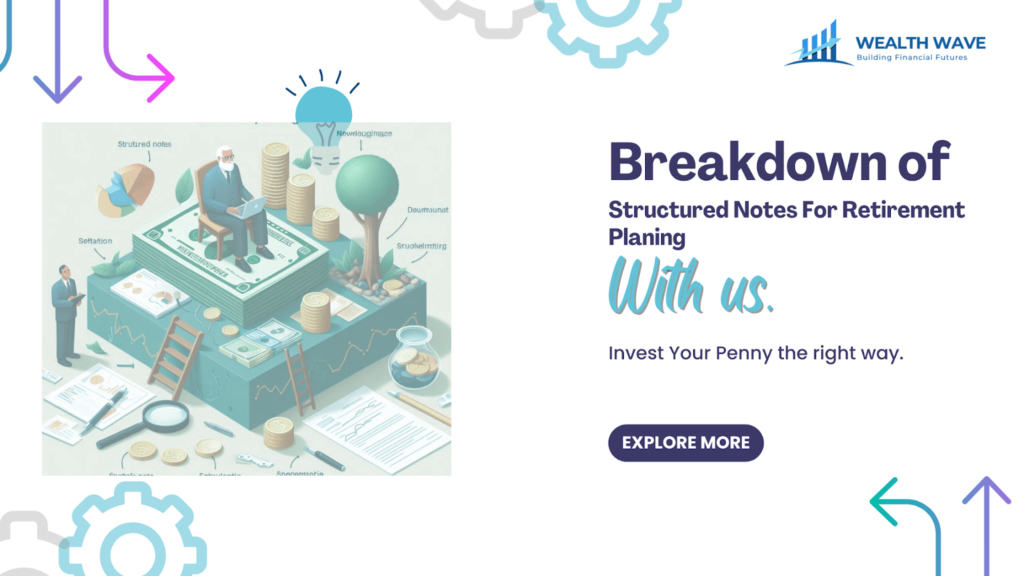People sock away pennies for retirement, hoping to build a nest egg. We’ve all been there. But what if there was a more reliable solution?
Enter structured notes for retirement planning – a game-changer in the retirement savings arena. We’ll explore how these innovative financial instruments can offer the security you crave, while potentially generating returns that traditional savings accounts simply can’t match.
Curious? Stick around as we explain how they could work for you!
What Are Structured Notes?
Structured notes combine stocks, bonds, and options to create a unique financial product. They aim to provide protection against the downside while offering a chance at higher returns.
Think of them as a blend between traditional investments and more complex strategies involving derivatives. This mix can be particularly appealing for those looking to diversify their investment portfolio beyond mutual funds or stock market picks without stepping completely into high-risk territories.
Originating in the U.K. during the early 1990s, these instruments have steadily gained traction among investors in the U.S., especially those with substantial assets and connections to private banks seeking specialized payouts.
Structured notes stand out because they can be customized to fit an investor’s risk tolerance, goals, and interests in various underlying assets – from equities and commodities to currencies and government bonds.
Structured notes offer a bridge between conventional investments and alternative asset classes.
As we shift our focus towards understanding the key benefits structured notes bring into retirement planning, it becomes clear why they are becoming a staple in diversified investment portfolios.
Key Benefits of Using Structured Notes in Retirement Planning
In planning for retirement, using structured notes can make a big difference. These financial tools offer ways to shape payouts to fit what you need and open doors to more growth, making your investment blend more varied and stronger.
Customized Payout Options
We offer customized payout options with structured notes. This means you can choose how and when you get money from your investment. Whether you prefer receiving regular dividends to support your retirement income or a lump sum at the end of the investment term, we tailor payouts to meet your needs.
Customized payouts help manage cash flow according to personal financial plans.
Our approach allows for adjustments based on market values and interest rates, ensuring that our clients benefit from higher yields in good times while maintaining some level of protection during downturns.
By leveraging options contracts within these structured products, clients have the flexibility to diversify their portfolio without sacrificing potential returns or exposing themselves to unnecessary risk.
This balance between risk and return is crucial for achieving long-term financial goals in retirement planning.
Potential for Higher Returns
Structured notes offer a clear path to higher returns, especially with growth notes linked to market indexes like the S&P 500. By tying these products to the price appreciation of such an index, investors gain enhanced upside potential.
For instance, imagine investing in a three-year structured note tied to the performance of the S&P 500. This particular note might come with a return multiplier of 1.15 times and include a cap at 25%.
It means if the index performs well, we see our investment grow significantly within a set period.
We seek opportunities where our capital can work harder for us, aiming for high yield without overlooking risk management principles inherent in structured notes. These financial tools blend elements from different investment vehicles—like fixed income securities and derivative instruments—to craft solutions that could outperform standard rate of return benchmarks on direct investments like stocks or bonds.
With proper portfolio management and strategic asset allocation, we position ourselves to potentially maximize investment returns while still managing through market volatilities efficiently.
Diversification of Investment Portfolio
Diversifying our investment portfolio is like planting different types of seeds in a garden. We spread out risks by not putting all our eggs in one basket. Structured notes allow us to invest across various assets, including stocks, bonds, and alternative investments.
This mix can help protect our money against market swings.
The wise investor sees structured notes as a tool for spreading risk and seeking potential growth.
By adding structured notes to our investments, we’re not just relying on traditional stocks or bonds. Instead, we introduce a new layer of protection with built-in downside protection features on some products.
These instruments often come with the opportunity to participate in market gains while shielding us from some losses. This strategy empowers us to aim for better returns without risking everything on one bet.
Common Types of Structured Notes
Among structured notes, Principal-Protected Notes and Barrier Notes stand out as popular options. Each offers unique benefits that can align with different retirement goals. To find out more about how these financial vehicles work and which might fit your retirement plan the best, keep exploring our insights.
Principal-Protected Notes (PPN)
We find Principal-Protected Notes (PPN) a secure choice for our retirement plan. These notes keep the initial money safe even if the market dips. Yet, they tie to credit risk. This means we could face a zero return if the issuer fails.
We keep in mind that PPNs also come with caps limiting high returns.
These investments carry an average fee of 2.9%, which is quite steep compared to other options like exchange-traded funds or certificates of deposit. Despite these costs and risks, we consider them because they promise to protect our principal investment against market downturns while offering a chance at gains tied to specific assets’ performance.
Barrier Notes
Moving from Principal-Protected Notes, we now explore Barrier Notes which offer a different flavor of investment opportunities. These notes are for those who seek exposure to market gains while maintaining some level of protection against losses.
They work by setting a barrier or threshold that the underlying asset must hit or exceed for investors to see returns. If the market performs well and crosses this predefined level, investors can enjoy capital gains.
Conversely, if the asset fails to meet this mark, your losses could be limited based on the specific terms of your note.
Barrier Notes often appeal to people looking for ways to diversify their portfolio without directly investing in exchange-traded funds (ETFs) or stocks. Consider these structured products as a bridge between traditional fixed-income investments and more volatile markets.
They allow investors to tap into potential growth opportunities with a safety net in place, making them an intriguing option for those aiming to strike a balance between risk and reward.
Structured Notes like Barrier Notes combine the potential for high returns with protective features against downturns, offering an innovative way for investors to approach their retirement planning.
How Structured Notes Work
We choose how much to invest and the terms we’re comfortable with in structured notes, then banks use our money in complex financial markets. Discover more about turning these choices into potential gains for retirement.
Investment Mechanism
We invest in structured notes by tying our money to the performance of a specific market index, like the S&P 500, or other assets. This choice means how much we earn depends on if these indexes do well.
Structured note creators use complex financial tools such as options and forward contracts to set up these investments. They aim to give us returns based on certain market conditions.
Our investments go through several stages before they start earning for us. First, investment banks design the structured notes and decide their features, like protection levels against losses and how gains are calculated.
Then, broker-dealers sell these notes to investors like us or our financial advisors who have assessed their fit within our retirement plans. Throughout this process, entities such as the U.S Securities and Exchange Commission (SEC) and Financial Industry Regulatory Authority (FINRA) oversee everything to make sure it’s all above board.
Payout and Tax Implications
We need to pay close attention to how structured notes get taxed. Often, they are taxed at the ordinary income rate. This rate is higher than the capital gains rate that usually applies to investments held for more than a year.
So, our gains from these notes might not be as high after taxes.
Selling these notes before they mature can also pose a challenge. The reason is their illiquidity. It means finding someone to buy the notes from us on secondary markets can be hard.
This makes it tricky if we need our money back before the note’s term ends.
Next, let’s discuss the advantages of investing in structured notes.
Pros of Investing in Structured Notes
Investing in structured notes can protect you if the market goes down, and let you invest in a variety of assets. This makes your investment strategy more diverse and could lead to better gains.
Explore how these financial instruments fit into your retirement plan for a hopeful future.
Downside Protection
We offer structured notes with downside protection to keep your investment safe from big drops in value. This means if the market turns bad, these notes can shield you from heavy losses.
There are two types of protections we use: soft protection and hard protection. Soft protection puts a barrier on how much you might lose, while hard protection ensures you don’t lose beyond a certain amount, even if things get really tough.
These strategies help diversify your portfolio by adding layers of safety against unpredictable market changes. With such features, we aim to give our clients peace of mind knowing their retirement savings have some buffer against volatility.
Next up, let’s talk about the different assets you can be exposed to through investing in structured notes.
Exposure to Various Assets
Structured notes give us a way to connect with a mix of assets like company shares, market indexes, and raw materials. This means we can spread our bets across different investments.
So, if one type of investment drops in value, others might do better and balance things out. It’s like having eggs in several baskets instead of just one.
We also get to test the waters in both calm and stormy financial climates. Stretched stock values? Check. Big ups and downs in prices? Covered. Super low interest rates? No problem.
Structured notes work as a bridge over these tricky situations, making them a solid choice for our retirement savings plan.
Structured notes – A bridge over complex financial waters.
Cons of Investing in Structured Notes
Investing in structured notes also comes with its own set of challenges, such as the risk of the issuer defaulting and less chance to sell quickly without losing money. High costs can eat into profits too.
Dive deeper to learn how to weigh these factors for your retirement plan.
Credit Risk
We must check the credit ratings of banks that issue structured notes because they carry a credit risk. This means if the bank faces financial trouble, our investment could suffer.
It’s similar to lending money to a friend who might not pay it back; we rely on the bank’s ability to honor its commitments. By understanding an issuer’s creditworthiness, we make more informed decisions and protect our investments.
Using tools like Standard & Poor’s 500 Index helps us assess the financial stability of these institutions. Securities provided by reputable banks may seem safe, but market sentiments and economic downturns can affect their ability to meet obligations.
We always advise looking into the issuer’s health before investing in structured products, as this step is crucial for safeguarding our retirement funds from unexpected financial crises.
Limited Liquidity
Selling structured notes before they mature is often hard. This challenge comes from their limited liquidity, which means they are not easy to trade or sell quickly. For anyone holding these investment products, this can pose a problem if they need to access funds before the maturity date.
Our advice always includes understanding this aspect of structured notes as it impacts how flexible your investment can be.
Liquidity refers to how quickly an investment can be sold for cash without affecting its price too much.
We advise our clients at the financial planning stage that these assets might remain with them until they reach their maturity date. During consultations, we stress the importance of aligning investments like structured notes with your long-term retirement plans.
The U.S. Securities and Exchange Commission (SEC) also suggests investors fully understand the terms and conditions associated with such securities, including their market liquidity aspects.
High Fees
After discussing the challenge of limited liquidity with structured notes, we now turn our attention to another downside: high fees. These costs can eat into your returns, making it crucial for us to factor them into our investment decisions.
Structured notes often come with layers of charges that aren’t always clear upfront. From management expenses tied to their complex structure to potential issuance charges, investors need to stay alert.
We pay special attention to these fees because they directly impact the internal rate of return on our investments. Advisers and financial analysts might suggest looking at products with lower expenses or considering how the benefits of structured notes balance against their costlier aspects.
While seeking investment advice, it’s key we understand all related fees disclosed by an investment adviser or broker-dealer conforming to the Securities and Exchange Commission (SEC) guidelines.
By doing this important homework, we ensure that high fees don’t unexpectedly diminish our hard-earned retirement savings.
Who Should Consider Structured Notes?
Investors looking for a blend in their retirement savings might find structured notes appealing. Those with an eye on mixing stocks, bonds, and other assets into one should look at these financial products.
Assessing Suitability for Retirement Portfolios
We know that not all investments fit well with retirement planning. Structured notes might be a smart choice for those with more wealth, like high-net-worth investors and private banks.
These financial products offer unique benefits, such as the chance for higher returns and protection on your principal investment. But they also bring challenges like credit risk and limited liquidity.
Before adding structured notes to a retirement portfolio, we carefully weigh these factors.
We look at an investor’s long-term goals and see if structured notes match their needs. Given their complexity and fees, we suggest them mainly for savvy investors who understand how debt securities work.
Such investors often have access to advisors who can navigate the risks tied to credit or market timing issues. For someone looking for steady income without much risk, other options might suit better—like municipal bonds or CDs insured by the SIPC (Securities Investor Protection Corporation).
This way, we ensure our advice fits each individual’s retirement plan perfectly.
Steps to Invest in Structured Notes
To start investing in structured notes, first do your homework on the different options available. Next, get a clear understanding of all the terms and conditions involved. This ensures you make a choice that fits your retirement planning goals perfectly.
Keep exploring for more insights!
Researching Options
We start by looking at different kinds of structured notes. It’s crucial to check the issuer’s credit rating on each one. A good credit rating means the company is more likely to pay back its debts, which lowers our investment risk.
Next, we talk with a financial advisor. They help us understand complex ideas like call risk and embedded derivative. This step makes sure we pick the right structured notes for our retirement.
We also use online brokers to find available options. These platforms show us various structured notes, including principal-protected notes and barrier notes. By comparing these, we learn about their potential returns and fees.
We pay special attention to details like rate of interest and terms related to early withdrawal or sale of the note before its maturity date. Understanding these terms helps us avoid surprises later on.
Understanding the Terms and Conditions
We always make sure to read and understand the terms and conditions before investing in structured notes. This step is key because these financial products are quite complex. Knowing what you’re getting into helps avoid surprises down the road.
The terms detail everything from how your money grows to what happens if things don’t go as planned.
As we explore our options, we focus on growth notes and income notes, two main types of structured notes available. We also pay close attention to credit risks, fees, and how these investments fit within our overall retirement strategy.
Our goal is to pick products that match our needs without exposing us too much to uncertain market changes. By staying informed, we feel more confident in our choices and how they’ll help us reach our retirement goals.
Final Thought
Structured notes offer a smart way for us to plan our retirement savings. These financial tools give us the chance to see potentially higher earnings while protecting our money from big drops in market values.
With options like growth and income notes, we can pick what fits best with our goals and risk tolerance. They mix fixed payouts, stocks, and other investments in one package, making it easier for us to manage our retirement funds effectively.
Investing in structured notes for retirement planning could be a wise move for those of us looking into securing a stable financial future during our golden years.




